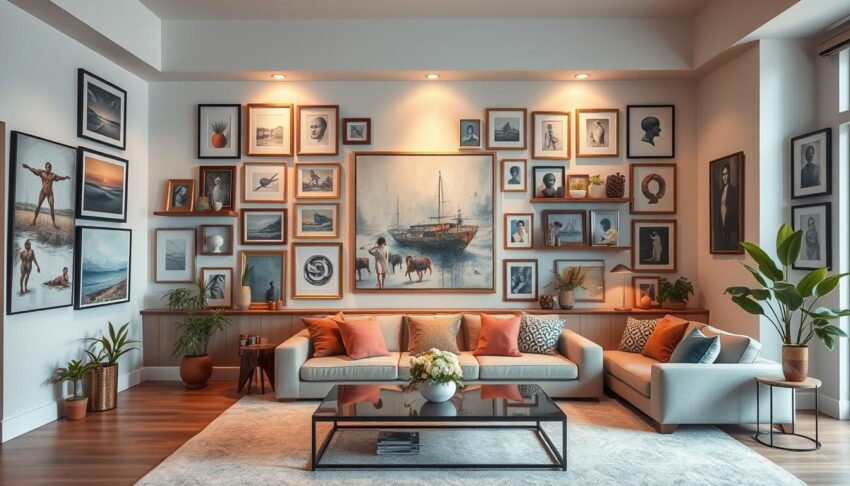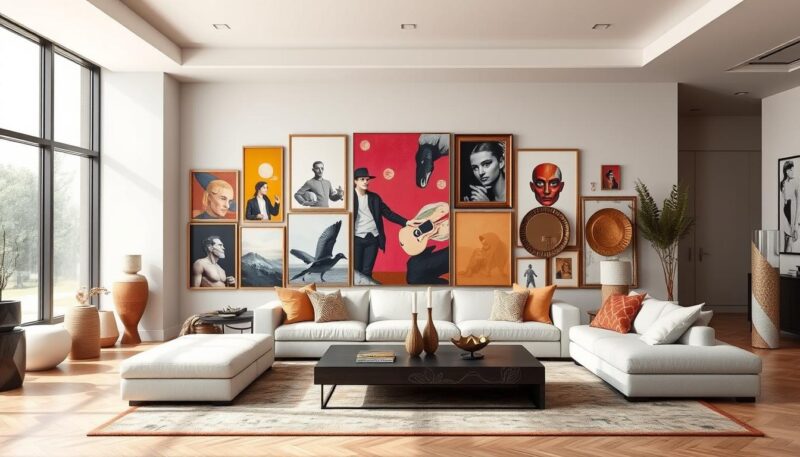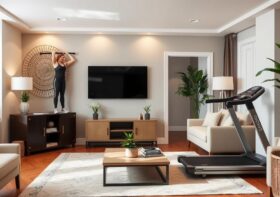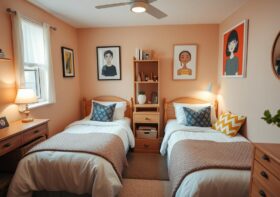How to Fill a Large Wall Space with Art and Decor? Interior Design Tips

Tackling a large wall space in your home can initially seem overwhelming, but it’s an opportunity to make a bold statement and infuse your personality into the room. Whether through art and decor ideas or functional additions, the possibilities are endless. With thoughtful planning and creative wall arrangements, you can enhance the visual interest of your living space and create compelling home styling inspiration. In this article, we provide a comprehensive guide filled with interior design tips to help you transform vast wall spaces into captivating focal points.
For those facing the intimidating prospect of styling a large blank wall, it’s essential to remember that sometimes less is more. Overloading a space can make it feel chaotic; giving certain areas room to breathe can enhance the overall impact of your design. Options abound, from incorporating large-scale art and mirrors to creating versatile gallery walls or installing built-in shelving for both style and storage.
One highly effective strategy is to embrace large-scale artworks or mirrors. A solitary, grand piece can dramatically elevate the room’s atmosphere while adding a touch of elegance. Another versatile choice is utilizing shelves or shelving units. Not only do they fill the space beautifully, but they also provide the practical benefit of added storage. If you’re willing to make a more substantial investment, built-ins offer a permanent and polished look.
Gallery walls are another popular choice for filling expansive wall spaces. By assembling various pieces of art in a cohesive theme, you can create a dynamic and visually engaging area. Moreover, the addition of a console table, complemented by art or a mirror, can add depth and dimension to the room. Even simple elements like peg rails or decorative hooks can provide both style and functionality.
Should your budget be more modest, don’t worry; there are plenty of DIY projects and budget-friendly options to explore. From making your own wall art to utilizing patterned wallpaper or framed gift wrap, you have numerous avenues to create a stunning wall that reflects your individual style.
Key Takeaways
- Large-scale art pieces or mirrors can be highly effective in filling a vast wall space.
- Experiment with creating a gallery wall to inject visual interest and a personal touch.
- Utilize shelves to blend storage and style effortlessly.
- Consider investing in built-ins for a more permanent and polished look.
- DIY projects and budget-friendly alternatives offer flexibility in personalizing your space.
Embracing innovation and creativity in home styling inspiration can transform the biggest, blankest walls into a beautiful canvas reflecting your unique taste. Integrating a mix of textural elements, color schemes, and functional decor enhances art and decor ideas while ensuring your walls are engaging and inspiring. Ready to dive into the specifics? Let’s explore how to use statement pieces for large walls next.
Utilizing Statement Pieces for Large Walls
When pondering how to effectively utilize your large wall space, statement pieces for large walls can offer a transformative solution. By selecting an impactful art piece or decor item, you not only infuse personality but also create a focal point that enhances your room’s aesthetic. Let’s delve into some essential design principles for wall decor.
Choosing the Right Statement Piece
Selecting the right statement piece involves considering both your room’s existing style and the wall’s dimensions. For instance, a dramatic mirror or an oversized art piece can serve as an eye-catching focal point. If your room has an eight-foot ceiling, a 72-inch high cabinet like the Amma from Scout & Nimble is an excellent choice. When selecting art, adhere to the guideline of choosing pieces that are half to three-quarters the width of the wall or furniture it will be placed over. This ensures a balanced aesthetic and maximizes wall potential.
Placement Tips for Maximum Impact
Proper placement of statement pieces for large walls is crucial to achieving their maximum impact. Ideally, hang standalone art at eye level, or slightly higher if it’s positioned above furniture. Consider incorporating lighting elements such as picture sconces to add a sense of grandeur and intentionality. Leaning large mirrors can also offer flexibility and convey a sense of spaciousness. For a dramatic effect, consider the three-eighths rule when placing art on a blank wall, ensuring adequate blank space on either side for optimal balance. Additionally, exploring techniques like outlining the area with painter’s tape or using paper cutouts can help you visualize the placement before making it permanent.
Here’s a detailed comparison of different examples to guide your choices:
| Wall Length | Type of Decor | Example |
|---|---|---|
| 19 feet | Art | Simple gallery wall (60%) |
| 26 feet | Architectural Piece | Large fireplace or breakfront (20%) |
| 12 feet (above furniture) | Mixed Media | Eclectic gallery wall (40%) |
Remember, while traditional guidelines offer a solid foundation, don’t hesitate to infuse your personal style, creating a unique and captivating focal point in your space. Experiment with different display options to find what truly resonates with you, and transform your blank walls into vibrant showcases of creativity.
Creating a Gallery Wall for Visual Interest
Creating a gallery wall can transform a large, empty space into a captivating display of art and personal expression. This design technique adds layers of color, texture, and emotion to a room, making it feel more vibrant and lived-in. Importantly, a gallery wall serves as a focal point, adding visual interest and a personal touch to your space.
How to Arrange Art Pieces
, it’s crucial to allow each piece a few inches of breathing space to ensure a balanced look. Play with the scales of different artworks to enhance visual interest. While you want a variety of sizes, ensure that the visual weight is evenly distributed to prevent one section from appearing too heavy. Picture hanging tools like the Markit Picture Hanging Tool and an Auto Leveling Laser + Stud Finder can assist in achieving precise and efficient layouts.
Symmetrical and asymmetrical features can both be incorporated to achieve a particular aesthetic. For a symmetrical display, consider a clean, grid-like arrangement, which creates a modern and organized feel. Conversely, an asymmetrical layout adds a sense of dynamism and eclectic charm. Planning your layout using paper templates can help you envision the design without committing to nail holes immediately.
Choosing a Cohesive Theme
Selecting a cohesive theme is pivotal in creating a gallery wall that feels curated rather than chaotic. A cohesive theme selection might involve choosing a consistent color palette or sticking to a specific genre of art. Starting your design with one central art piece can provide a focal point around which other pieces can be arranged.
Utilize resources like interior design magazines, Pinterest, and Instagram for inspiration. You may also create a mood board to help visualize your cohesive theme. When purchasing art pieces, consider platforms like Etsy for unique finds. Opt for frames wisely—purchasing them on sale at stores like Michaels or Hobby Lobby can help you avoid unnecessary expenses. Mixing different art forms and frame styles will add a multidimensional aspect to your gallery wall.
Understanding the significance of frame and mat choices can also enhance the overall look of your gallery wall. By carefully balancing large wall spaces with various frame sizes and types of art, you can achieve an aesthetically pleasing and cohesive display.
Incorporating Functional Decor
Integrating functional decor elements into a large wall space not only merges aesthetics with utility but also ensures your interior design stays both practical and stylish. Incorporating this concept can transform a room’s vibe while offering additional space for storage and display. One of the most popular trends in the interior design industry, functional decor has shown its lasting popularity through various creative approaches.
Using Shelving Effectively
Using shelving effectively is a key strategy for making the most out of your wall space. Shelves provide a platform for displaying cherished items, contributing to a warm and inviting atmosphere. Consider the following practical interior design tips for arranging your shelves:
- Align shelves with architectural elements like windows or doors for a cohesive look.
- Opt for built-in bookshelves to expand storage possibilities.
- Use a mix of open and closed shelving to balance functionality and style.
- Place items in a way that guides the eye naturally across the room.
Properly positioned shelves can enhance not just the functionality of your living space but also its visual appeal, blending art and functional decor seamlessly. Shelving can also complement other decor elements like framed art, mirrors or textured vases, adding depth and variety.
Blending Storage with Style
Blending storage with style is essential to achieving a harmonious interior design. This goes beyond merely stacking books or decorative items; it’s about creating a visual narrative that resonates with your personal aesthetics. Here are some tips:
- Choose shelves that reflect the overall theme of your room.
- Incorporate decorative elements like baskets, vases, and books to add texture and warmth.
- Scale your shelving to match the proportions of the wall space for balance.
- Utilize creative lighting to highlight specific items and create ambiance.
Incorporating varied decor items and paying attention to the scale and proportion when placing shelves ensures a stylish yet functional decor setup. Remember, practical interior design tips like these can turn any large wall into a focal point that marries both form and function.
“Decorating a large wall with functional decor requires a blend of creativity and practical interior design tips. It’s about turning a vast space into a cohesive narrative of your style and needs.”
These strategies help in blending art and functional decor into your living space, ensuring your home feels both cohesive and inviting. Always consider your room’s architectural features and the overall harmony to create an environment that is not just beautiful but also highly functional.
Using Layered Decor Techniques
Layered decor techniques offer a dynamic and nuanced approach to filling large wall spaces. By starting with a larger, anchoring piece—such as a grand piece of art or a tapestry—you create a focal point that commands attention. From there, you can layer in smaller pieces like framed prints or decorative plates to add depth and visual interest. The key to mastering these techniques lies in integrating a mix of textures and colors to keep the eye moving and engaged.

Utilizing empty spaces creatively is crucial for achieving a well-balanced look. Wall-mounted elements like mirrors or clocks can be layered gracefully with leaning artwork or textiles to create a multifaceted aesthetic. Mirrors, in particular, are favored by 75% of homeowners for their ability to enhance the visual appeal of a room.
When you integrate texture and color into your layers, you not only enrich the design but also inject personality into the space. For instance, combining wood slat blinds with drapery panels adds dimension, and mixing bold-colored or patterned pillows with soft neutrals transforms a room’s vibe. Additionally, layering lighting—including overhead lights, table and floor lamps, and accent lighting—creates a visually balanced and inviting atmosphere.
Decorative accessories serve as the final layer in your decor, showcasing your personality and drawing attention to desired areas. Adding seasonal decor can keep your space feeling fresh and timely, as evidenced by the 55% of households that update their wall decor according to the seasons.
Whether it’s through gallery walls, with 62% of interior design professionals recommending them, or using textile art—reflecting a 45% increase in sales at craft stores—layering in decor transforms large walls into stunning features of your home. This table provides a quick overview of the key elements in layered decor techniques:
| Layered Element | Description | Statistics |
|---|---|---|
| Gallery Walls | Creates visual interest through a cohesive arrangement of art pieces. | 62% of interior design professionals recommend |
| Mirrors | Enhances visual appeal and creates the illusion of more space. | 75% of homeowners use decorative mirrors |
| Textile Art | Incorporates woven textures and patterns to add warmth. | 45% increase in sales at craft stores |
| DIY Wall Art | Personalized artwork that adds unique character to walls. | 60% of millennials prefer |
| Wall Clocks | Adds both functionality and a stylish focal point. | 38% increase in sales |
| Wall Sconces | Provides ambient lighting while contributing to decor style. | 80% of designers recommend |
| Seasonal Decor | Updates the look of the space to reflect changing seasons. | 55% of households change decor seasonally |
How to Fill a Large Wall Space with Art and Decor? Interior Design Tips.
Creating a harmonious and inviting atmosphere with decor starts with understanding the balance between size and scale. Filling a large wall space effectively avoids a cluttered or bare look and enhances the room’s overall vibe. Here are a few tips:
Balancing Size and Scale
Striking the right balance between the size of your wall art and the scale of the wall is crucial. Interior designers suggest using large landscape format pieces for high ceilings and portrait works for formal settings. This approach helps to break up the large expanse and add visual interest. Consider using paneling or a floor-to-ceiling bookshelf to create texture and character. Remember, filling the space with oversized artwork can draw focus and make a large wall feel appropriately filled, offering a sense of completeness.
DIY Wall Art Projects
DIY wall art projects offer a personalized touch to your decor, making your space truly your own. Handmade artwork can not only be cost-effective but also create an inviting atmosphere with decor that reflects your personality. Experiment with different materials and techniques; fabric is a budget-friendly option, and customizable wallpaper patterns are on the rise, providing endless possibilities. Embrace botanical patterns, projected to be the top trend in 2023, to add a fresh and organic element to your wall.
Consider organizing a gallery wall by arranging a mix of portrait and compact still-life studies. This informal display can create an intimate and engaging focal point. Additionally, mirrors can be strategically placed to reflect light and add dimension, making your space appear larger. Always ensure that your arrangements are proportional to the wall and complement the rest of the room’s decor, maximizing aesthetic impact.
Maximizing Aesthetic Impact
To maximize the aesthetic impact of your large wall space, consider integrating texture and color through various decorative elements. By doing so, you can create a visually dynamic and engaging environment that reflects your personal style. Here, we’ll explore effective methods of integrating diverse textures, bold colors, and establishing a focal point in your room.
Integrating Texture and Color
Integrating texture and color into your wall decor can significantly enhance its visual appeal. Textured elements, such as woven wall hangings, embossed metal decor, and wicker baskets, add a tactile quality that brings depth and character to the space. For instance, incorporating fabric textures like woven tapestries or textured wall panels can create a captivating spectacle.
Color integration is equally crucial. Consider painting a mural or hanging vibrant art pieces to add dimension and energy. Whether you choose bold colors to infuse energy or subtle tones for a calming effect, the right color choices can transform the atmosphere. Using color blocking techniques can also contribute to a more dynamic space.

Creating a Focal Point
Creating a focal point is an essential aspect of maximizing aesthetic impact. By strategically positioning a key piece of art or decor, you can draw the eye and anchor the room’s design narrative. For instance, placing an oversized piece of custom wall art in the center of a large wall ensures it catches attention immediately.
Complement this focal piece with additional elements like accent mirrors, tapestries with unique patterns, or artistic shelves. The key is to pair elements that enhance rather than compete with the focal point, creating a harmonious and visually stunning space. Examples like live edge wood shelves or ornate mirrors can beautifully complement a central decor piece.
Remember, the goal is to blend various decorative elements seamlessly to achieve a cohesive and inviting aesthetic. With thoughtful choices, integrating texture and color, and establishing a focal point, you can create a room that’s both visually striking and reflective of your unique style.
Incorporating Personal Collections
Incorporating personal collections into your home decor not only tells the story of your interests and experiences but also infuses your space with character and uniqueness. Whether your treasures are vintage finds, travel memorabilia, or objets d’art, creating a dedicated display for them can dramatically enhance your interior design. By thoughtfully curating and positioning your collection, you can transform it into an integral part of your room’s decor, providing conversation points and a warm, lived-in feel.
Wall-mounted display cases or individual shelves are excellent for both showcasing your collection and serving as eye-catching decor elements. To ensure cohesion, group similar items together or thematically link diverse pieces, creating a harmonious and visually appealing arrangement. For instance, incorporating personal collections such as curated vintage finds or travel memorabilia can add a unique personality to your space, making it feel more like home.
The arrangement and presentation can be enhanced by utilizing empty spaces creatively. This involves balancing personal items with other design elements, ensuring a seamless integration into your overall decor.
| Tips for Displaying Personal Collections | Effective Techniques |
|---|---|
| Group Similar Items | Arranging like items together for visual cohesion and impact |
| Mix Diverse Pieces | Thematically linking diverse pieces to create a unified display |
| Use Wall-Mounted Display Cases | Providing a secure and attractive environment for valuable items |
| Integrate Shelves | Offering flexible display options and additional storage |
Incorporating personal collections and utilizing empty spaces creatively are key to achieving a balanced and appealing interior. The strategic placement of your cherished items not only breathes life into your decor but also ensures your home reflects your unique personal style.
Conclusion
Transforming a large wall space with art and decor presents a unique opportunity to reflect your personality and elevate your home’s style. This guide has offered practical interior design tips to create stunning statement pieces, balanced gallery walls, functional yet stylish storage, and engaging layered decor techniques. By incorporating personal collections and utilizing crafty DIY projects, you can cultivate an inviting atmosphere with decor that maximizes both aesthetic appeal and everyday practicality.
Remember, the key is to plan meticulously and balance the size and scale of your decor items. Integrating texture and color, as well as creating a focal point, can significantly enhance the visual impact. Moreover, don’t underestimate the power of lighting; ambient lighting can bring your art pieces to life and make your space feel brighter and more welcoming. Reflective surfaces, such as mirrors, can also create an illusion of increased room spaciousness.
Don’t shy away from experimenting with geometric shapes and contemporary designs, as these can add a modern and visually striking aesthetic to your walls. Personalizing your space with cherished memories through photos and keepsakes can imbue your home with warmth and sentimental value. As highlighted, involving elements like ambient lighting and contrast in color themes can make your large walls not just a backdrop but a highlight of your interior.
By following these practical interior design tips, you strike a balance between creativity and functionality, making your large wall space an inviting and dynamic part of your home. Whether it’s for a living room with high ceilings, a bedroom, or any other area, plan deliberately, incorporate your unique flair, and enjoy the transformation that well-thought-out decor can bring to your environment.
Source Links
- https://stylebyemilyhenderson.com/blog/struggling-with-a-big-empty-wall-we-help-4-readers-you-figure-out-the-best-ways-to-fill-it
- https://studio-mcgee.com/4-ways-to-fill-a-big-blank-wall/
- https://www.marthastewart.com/8118411/how-decorate-large-wall-space-living-room
- https://laurelberninteriors.com/how-to-decorate-a-blank-long-living-room-wall/
- https://blog.cattiecoylephotography.com/interior-design/how-size-art-wall/
- https://sanctuaryhomedecor.com/how-to-decorate-a-big-blank-wall/
- https://www.mybreezyroom.com/gallery-wall-for-beginners/
- https://www.artfullywalls.com/artful-insights/how-to-make-a-gallery-wall-in-5-easy-steps
- https://www.architecturaldigest.com/story/wall-decor-ideas
- https://theinspiredroom.net/10-style-tips-for-a-large-living-room-ideas-great-rooms/
- https://www.homesandgardens.com/interior-design/should-every-wall-have-something-on-it
- https://www.worthingcourtblog.com/how-to-layer-decor/
- https://homeandtexture.com/layering-room-walls/
- https://decormatters.com/blog/6-affordable-ways-to-fill-a-large-blank-wall
- https://www.homesandgardens.com/interior-design/living-rooms/how-do-i-fill-a-large-living-room-wall
- https://www.hello-hayley.com/decor-ideas-for-large-walls/
- https://daraagrussdesign.com/blog/how-to-decorate-a-long-hallway/
- https://theownerbuildernetwork.co/custom-wall-art-ideas-for-compact-areas/
- https://stylebyemilyhenderson.com/blog/how-to-make-a-gallery-wall
- https://www.forbes.com/home-improvement/design/ways-to-style-wall/
- https://foyr.com/learn/best-wall-decor-ideas
- https://carlaaston.com/designed/wall-decor-solutions-for-tall-blank-walls
- https://thecopperwolf.com/blogs/news/how-to-arrange-art-on-a-wall-11-art-styling-ideas?srsltid=AfmBOorfUXmMal6IX0ogU2LXH7fbMSkFp3rrRkYp2qfks1ytsxV4F9_A


